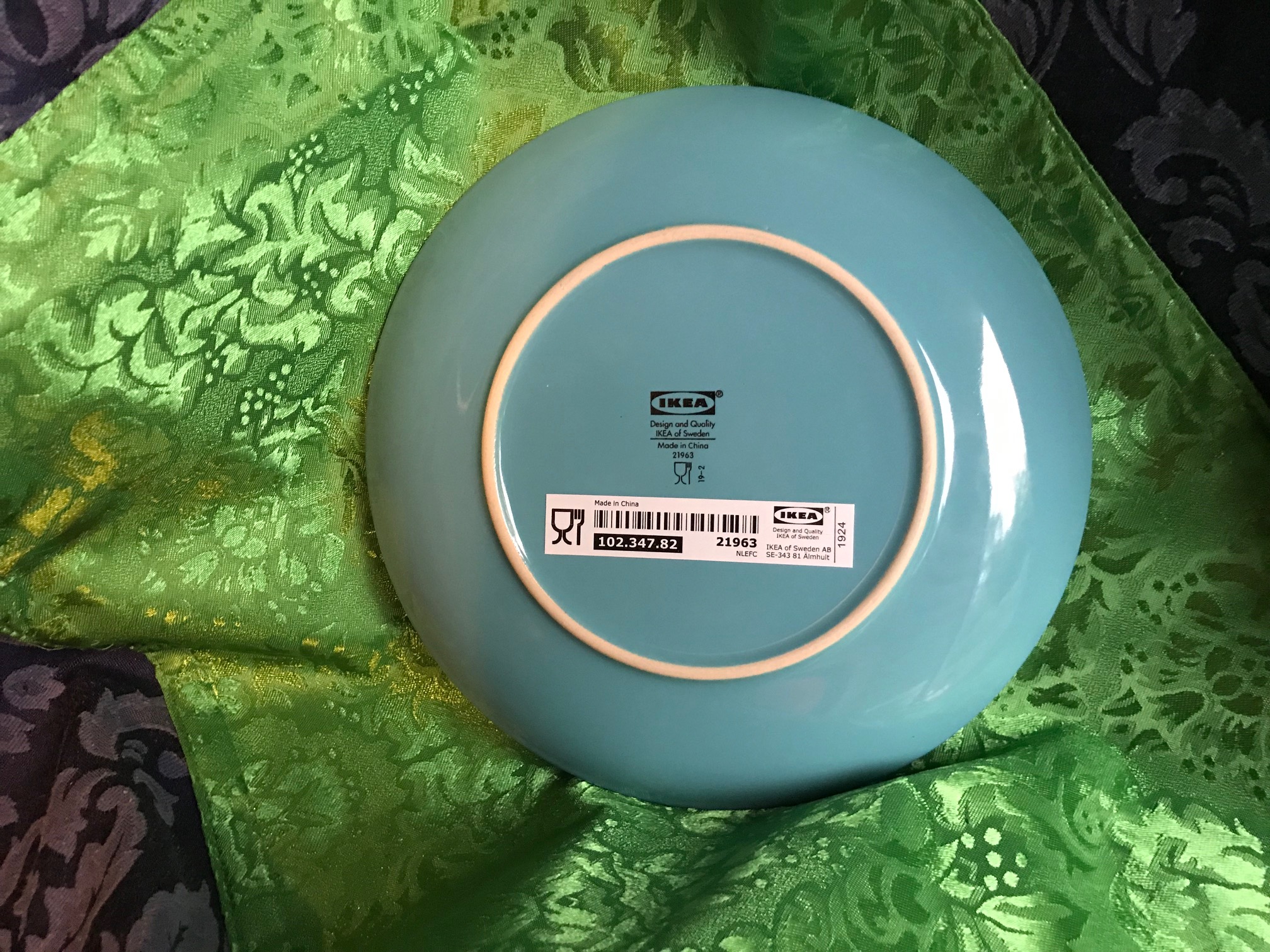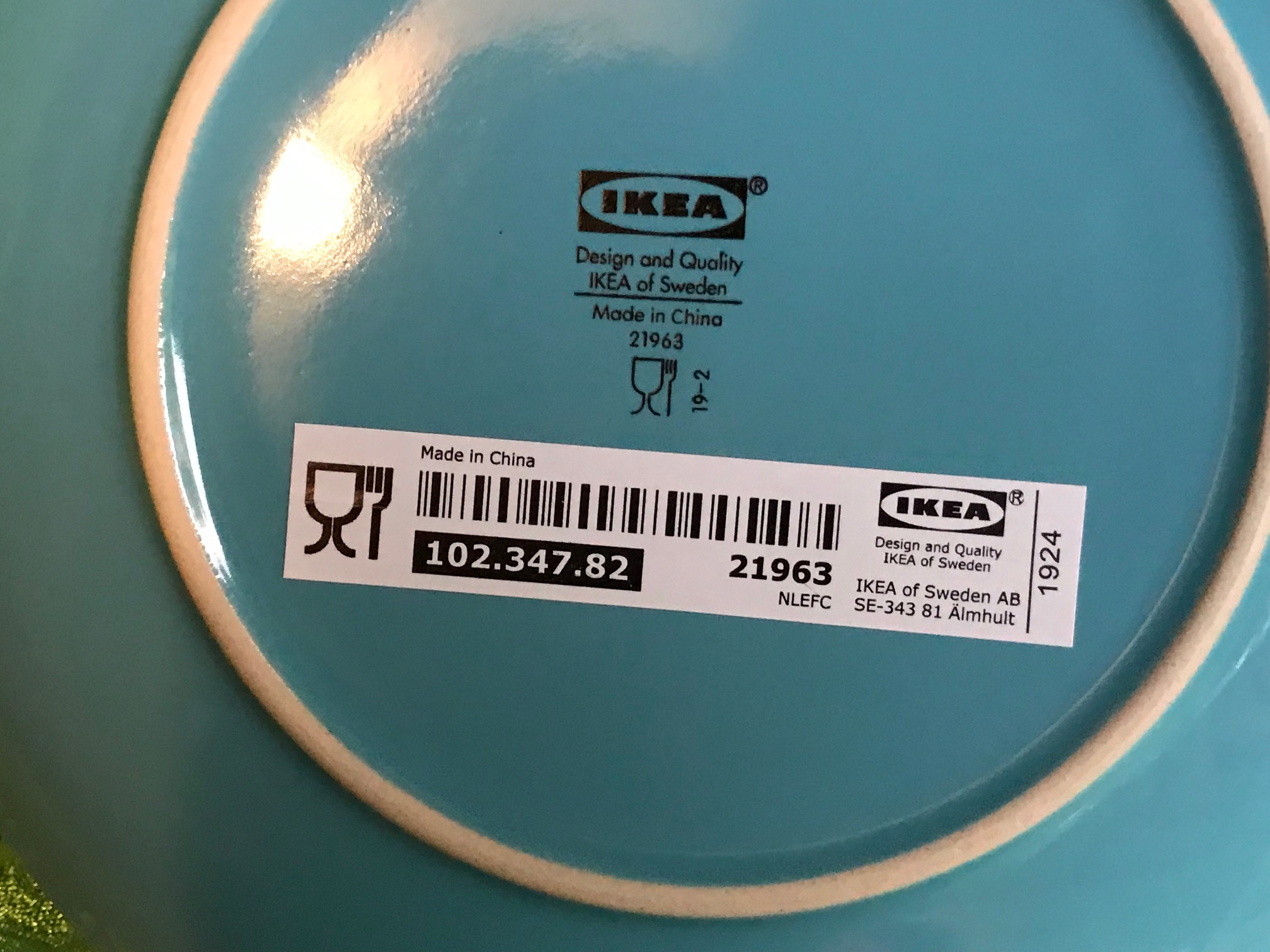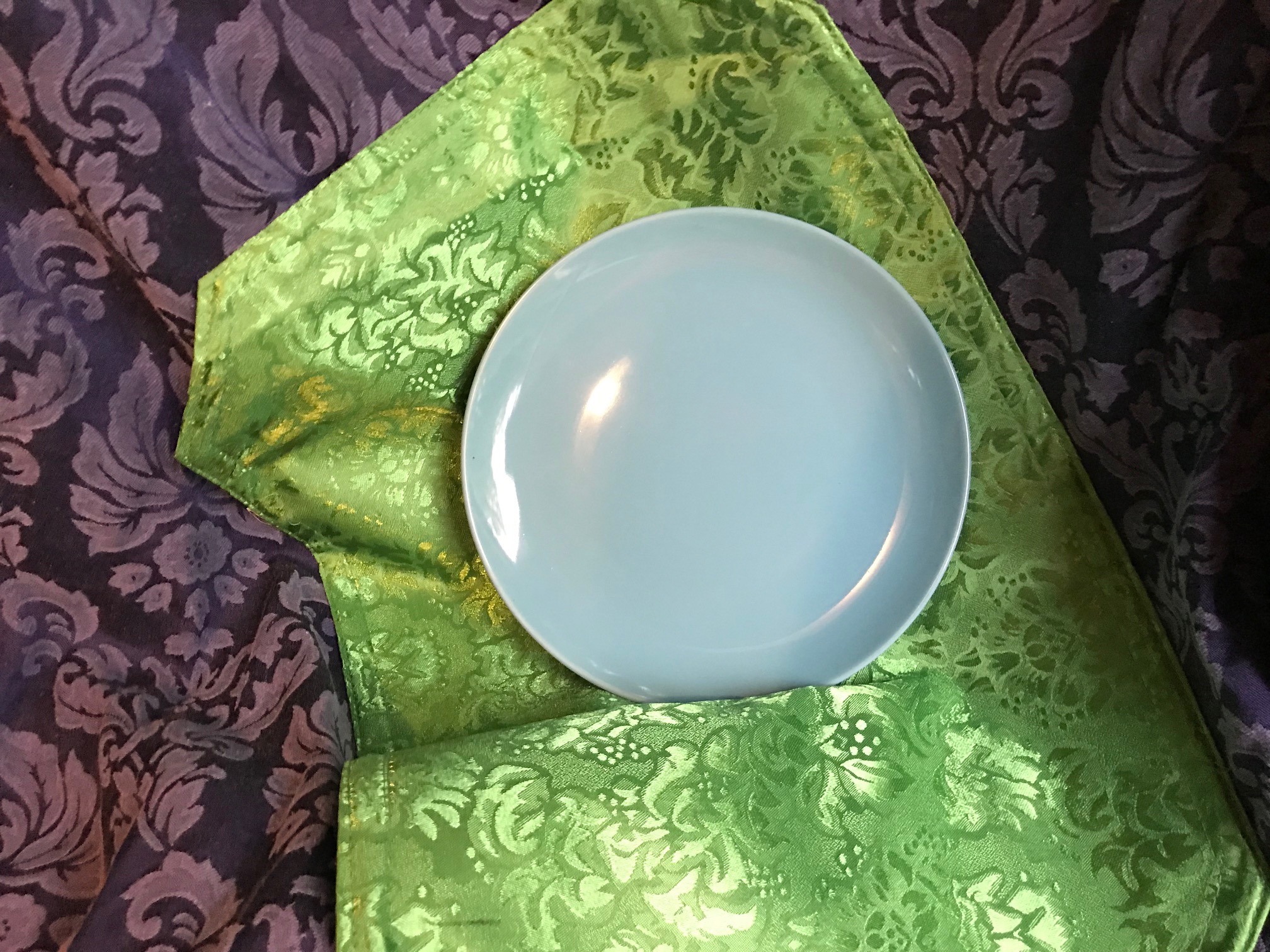2019 Ikea Brand, Made In China – Turquoise Fargrik Plate: 34 ppm Lead (Please read full post for details.)
 Background on my work testing Ikea products since 2009:
Background on my work testing Ikea products since 2009:
Since I get so many *Ikea* questions (and since I have long-recommended Ikea as a great general-purpose go-to brand), I decided to purchase some new, current Ikea plates myself, and post their test results here on the blog. With much of what I test and report on here on the blog being used items sent in by my readers, I don’t always know the date of manufacture, or the date of purchase – and often I also don’t know the manufacturer’s exact model number or color name (or pattern name). By purchasing some of these Ikea offerings brand-new at the store myself (in September of 2019), I can give my readers a definite picture of Ikea’s current offerings, and confirm whether or not they have Lead [and if they do, what the levels are].
In the past 10 years, Ikea has generally been a safe choice.
If you have been following my work for much of the 10+ years I have been doing (and reporting on) consumer goods testing (using XRF technology), you have probably read some or all of the following statements typed by my fingers:
- Nearly all Ikea products I have tested in the past 10 years have been either Lead-free or Lead-safe.
- By “Lead-safe” what I mean is that any Lead detected is within a “safe range” by the current best (European and U.S.) standards.
- Safe range is determined both by the level of Lead detected (taking into account the margin of error of detection) and the intended use of the product.
- NOTE: Prior to 2010 there are definitely examples of high-Lead Ikea items; please click this link to see one of those.
Overall, what were the results of the testing of new (2019) Ikea products?
Over the next day or two I will be posting more than 10 new (September, 2019 purchased) examples of Ikea products, with their XRF test results. While several of these examples are completely Lead-free, I want to mention (in this summary that I am including with each one of these posts) that some of these items have tested positive for a low-level of Lead [a level that is a fraction of what I find in most older dishes – but still slightly higher than what I would strictly consider to be in the “unquestionably Lead-safe” range]. As a result of these new findings, I intend to make periodic trips to Ikea to purchase more new examples and colors of their products so consumers can have a better sense of which NEW Ikea items are definitely either completely Lead-free, or Lead-safe.
Additionally, with each of these posts – as the items have been purchased new – I will be including photos of the back side of the item with the store label with the identifying model number and other relevant information, so my readers can make choices for their homes based on that information.
Important to note:
While some of these products may be positive for trace levels of Lead with XRF testing, I am confident (given Ikea’s use of European manufacturing standards) that they pass any relevant leach testing standards for toxicants at the time of manufacture. As always, my concern for Lead content in dishware is not for what happens when they are new – but what may happen in the long term, with years (or even decades) of regular use — daily use, as intended for food use purposes – including with hot and acidic foods – like coffee, lemonade, salad dressing and tomato sauce, and machine dishwashing, chipping and wear (or breakage), etc. over the years.
What are the exact XRF test results for the dish pictured in this post?
Food surface of the plate (180-second test):
- Lead (Pb): Negative / Non-Detect
- Cadmium (Cd): Negative / Non-Detect
- Mercury (Hg): Negative / Non-Detect
- Arsenic (As): Negative / Non-Detect
- Antimony (Sb): Negative / Non-Detect
- Barium (Ba): 766 +/- 54 ppm
- Zinc (Zn): 21,400 +/- 400 ppm
- Copper (Cu): 399 +/- 39 pm
- Iron (Fe): 1,140 +/- 122 ppm
- Vanadium (V): 1,239 +/- 54ppm
- Titanium (Ti): 1,655 +/- 75 ppm
- Zirconium (Zr): 20,300 +/- 400 ppm
- Platinum (Pt): 283 +/- 73 ppm
Unglazed rim on the backside of the plate (120-second test):
- Lead (Pb): 34 +/- 11 ppm
- Cadmium (Cd): Negative / Non-Detect
- Mercury (Hg): Negative / Non-Detect
- Arsenic (As): Negative / Non-Detect
- Antimony (Sb): Negative / Non-Detect
- Barium (Ba): 246 +/- 43 ppm
- Tin (Sn): 39 +/- 15 ppm
- Zinc (Zn): 10.500 +/- 200 ppm
- Copper (Cu): 270 +/- 37 ppm
- Iron (Fe): 3,100 +/- 194 ppm
- Bismuth (Bi): 92 +/- 15 ppm
- Vanadium (V): 762 +/- 44 ppm
- Titanium (Ti): 1,271 +/- 70 ppm
- Zirconium (Zr): 9,384 +/- 195 ppm
- Platinum (Pt): 172 +/- 60 ppm
All [2019] tests reported on my blog are done for a minimum of 60 seconds per test (unless otherwise noted), using a freshly-calibrated XRF instrument, testing in “Consumer Goods” mode. Testing is always repeated in each instance to confirm the results. Results are science-based, accurate (within the margin of error noted), and replicable. Metals not listed were not detected by the XRF in Consumer Goods mode.
Conclusion:
I would consider this dish to be in the “Lead-safe” range. Given Lead was detected only on the unglazed ceramic (the rim on the back side of the piece) it appears that the glaze is, in fact, Lead-free.
As a matter of principal, I would personally not select these particular dishes for my home, but if you served me food on them when I was visiting your house, I would certainly not have any concern. Again, the concern with any amount of Lead in dishware is what could potentially happen over the long-term, from heavy use, wear and abuse/mishaps, etc. You can read more about that on this post – link. It is my personal opinion and stand (more based on ethics and politics than based on the amount of Lead in any one dish) that there should be no Lead at all in any dishware, which is why I choose to use undecorated, plain white glass (or clear glass) dishes in my home.
To see the dishes I use every day with my family, click here.
Overall, I still consider Ikea a great brand — however, I stick by my general philosophy when it comes to dishware that I feel confident to have kids eating off of daily: dishes should be simple and plain, decorated only with the food you serve on them – not with glazes, paints or other decorative coatings. That is your best bet, across the board.
I am not particularly enthusiastic about (the quality or durability of) Ikea furniture, but their stainless pots and pans tend to be low-nickel (which is a good thing and preferred by many consumers), and their ceramics and glassware still skew to mostly being Lead-safe or Lead-free.
To see more Ikea products I have tested, click here.
As always, thank you for reading and for sharing my posts.
Please let me know if you have any questions.
If you appreciate the work I do (especially the consumer goods test results that I report here on this blog), please consider making a small contribution to help cover the costs of these types of (unfunded / unsponsored) posts. Here’s the “Chip-In” link with a bunch of different ways to contribute. Here’s a post with all the different ways you can hire me (an even better way to help support what I do!)
Tamara Rubin
#LeadSafeMama
Ikea glazed ceramic plate model: 102.347.82
21963 • Made in China

Never Miss an Important Article Again!
Join our Email List


 Background on my work testing Ikea products since 2009:
Background on my work testing Ikea products since 2009:

Thank you SO much for doing this, Tamara!
Hi Skye! You are very welcome! It is an interesting exercise!
Tamara
I really appreciate you doing this! I love Ikea and have a couple pieces of dishware from Ikea. The pieces I have are kind of like a milk glass material (white). They’re made in France. I bought them this year. Based on your testing of IKEA dishes I’m not too worried about them. But it’d be interesting to see you test them if you get the chance.
OK, so on Ikea’s website it says “no lead or cadmium” added to the dishware. I have. Hmm…
Oh good. I went to Ikea today and bought new dishes after tossing out much of my vintage stuff.: ( The good is that I bought this very same turquoise Fargrik dishes. Glad to see they’ve tested pretty clean.
Yes the glaze appears to be 100% Lead free.
T
My 7 year old son tested very high on Aluminium. The first thing I checked was my cooking pots, which are mostly from Ikea and it turns out they do contain Aluminim (!) little did I know. Aluminium is linked with Alzheimer desease in adults, imagine what it does to children. Please also do a research on ikea cooking pots on Aluminium.
Hi Ingrid,
I am not sure what pots you have – but the pots from Ikea that I have tested have not been positive for Aluminum in any of the food accessible surfaces. Here is one example: https://tamararubin.com/2018/11/2018-ikea-stainless-2-5-liter-cooking-pot-leadfree/
Thank you for commenting!
Tamara
Ingrid, you can give him Fiji water to help detox the aluminum. The high silica in Fiji brand water has been proven to bind and eliminate stored aluminum in those with Alzheimer’s.
Hello,
I’d be glad to help identify your tested IKEA dinnerware. I”m good at it, actually responsible for two glass patterns and one dinnerware going collectible via identification.m FWIW
Most of it is still available in the store but, there are major cities with a midcentury yen; new york, famously, who prefer online ordering and the demand for IKEA hasn’t slowed.